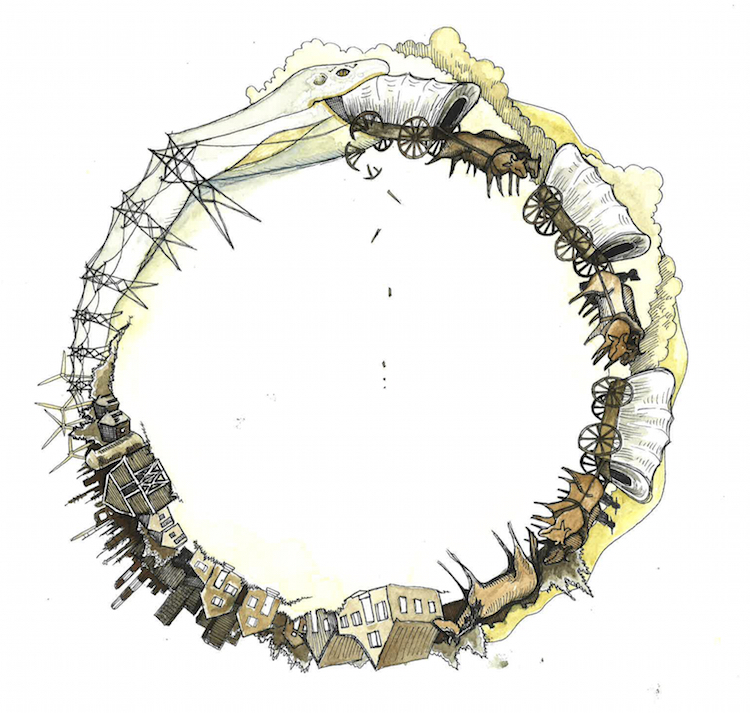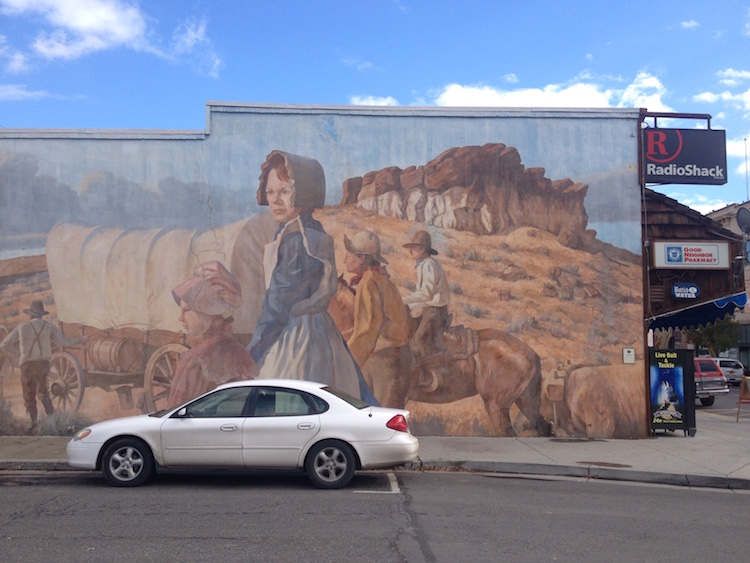 The first time I played the Oregon Trail computer game – a parody of American westward expansion inflicted on countless school kids – was this winter. I was snug in bed, as befits a prospective pioneer facing one of history’s largest human migrations. Up to 500,000 settlers set out along the Oregon and California Trails in the mid-19th century. For my own treacherous 2,000-mile trip, I chose to be a banker from Boston, because I had just seen The Big Short and longed to inflict virtual revenge on the financial sector. I named this banker Beverly, since the game gave me no option to be a woman. Beverly’s sundry family members would be Pot Roast, Potato, Death, and – improbably in this bunch at least – Steven.
The first time I played the Oregon Trail computer game – a parody of American westward expansion inflicted on countless school kids – was this winter. I was snug in bed, as befits a prospective pioneer facing one of history’s largest human migrations. Up to 500,000 settlers set out along the Oregon and California Trails in the mid-19th century. For my own treacherous 2,000-mile trip, I chose to be a banker from Boston, because I had just seen The Big Short and longed to inflict virtual revenge on the financial sector. I named this banker Beverly, since the game gave me no option to be a woman. Beverly’s sundry family members would be Pot Roast, Potato, Death, and – improbably in this bunch at least – Steven.
Predictably, Death was first to die. She drowned along with two oxen not long after we embarked from Missouri, when I tried to ford a river instead of paying the toll for a ferry. Steven, meanwhile, was plagued by misfortunes that will be familiar to all who’ve played this game. First he was exhausted, then broken-armed, then grappling with dysentery, then lost, then down with cholera. I finally ended his misery by crashing the raft bearing our covered wagon into a rock on the Columbia River, drowning us both near the end of the line in Oregon.
The game is a culty 1970s simplification of a complex historical event that contributed to the violent displacement of indigenous people and laid the foundations for today’s urban Northwest. But Americans have been preoccupied with valorizing and simulating the pioneer experience almost since the United States began colonizing the West Coast. Some three million revelers attended re-enactments and other festivities held along the Oregon Trail for its 1993 sesquicentennial. Each summer in Wyoming, thousands of Mormons haul heavy handcarts in a sort of pilgrimage over a section of the Mormon Pioneer Trail, which shares a corridor with the Oregon and California trails. A journalist recently built a covered wagon and traveled the Oregon Trail with his brother, penning a book that topped the New York Times bestseller list last year. Even the National Park Service, which administers the Oregon and several other designated National Historic Trails, makes it a goal to support the vicarious emigrant experience by protecting those sites and trail segments along the route that still have intact wagon ruts and sweeping views, much like those pioneers would have seen.
Hoping to understand this emigrant trail obsession a bit better for a feature I was writing, I met up with Gail and Muriel Carbiener last November. The elderly couple belongs to the Oregon-California Trails Association, which is fighting a massive electrical transmission line proposed for northeastern Oregon that will be prominently visible from some of those pristine ruts that devotees hold so dear. Because much of the trail has already been lost to time and development, the group works hard to conserve what remains as a sort of monument.
We stood in the freezing mud at a place on the trail called Birch Creek, near where the line would cross, and Gail asked me to imagine that it was 100 degrees – as it would have been during the season when emigrants came through. Your nose is choked with dust, he told me, and your oxen’s too. And there is so much dirt kicked into the air that the wagons stretching before and behind you are almost completely obscured. Besides some fencelines and the top of a cellphone tower peeking from behind a ridge, the landscape did look timeless and lovely from here: velvety hills stretched away in all directions to a turbulent sky. “This is exactly perfectly the same as what the original settlers would have seen,” Gail said. “It’s the same weeds. The same grass.”
Muriel had done her part to complete the picture: She peered from a cavernous sunbonnet, and her ankle-length dress billowed over a stiff bell of petticoats and stout corset. It couldn’t have been more than 40 degrees out and the wind made it feel much colder, but she had declined to wear her contemporary parka because it wouldn’t be authentic. She looked cold.
“I cannot explain this to you, the feeling that we get along the trail,” Muriel said. In places where the land is still open and quiet, both the Carbieners told me they could sense the presence of people who walked or died there so long ago. The vistas helped animate experiences the couple had learned about in settler diaries. As we visited another set of ruts further south, the Carbieners described some of those settler experiences to me: a litany of hardships that sounded remarkably like those that my fictional relative Steven had endured in the Oregon Trail game.
“So…it’s just like this horribly unpleasant journey,” I observed.
“It is!” Muriel laughed. “Thank you! You get it! And you’ve got children along. The emigrants have large families.”
“And you’re pregnant!” Gail chimed in.
“And you’re going to give birth!” continued Muriel.
Losing connection to the power of those stories seemed to be what the Carbieners feared most about the march of development. And as we drove between sites, it became clear just how much Gail thought the intrusion of modernity ruined the trail. He asked the photographer that had accompanied us for the day to consider cropping out nearby roads and even the couple’s Jeep. When I told Gail I wanted to see the place where emigrants crossed the Snake River between Idaho and Oregon, he seemed genuinely baffled and told me repeatedly that there was “nothing there”: Farm fields had already covered the spot.
While federal ownership and large private ranches have preserved a lot of land here, as in much of the West the rest has been heavily altered by the settlement that pioneers kickstarted. The nearby town of Ontario, Oregon is a worn sprawl of chain motels and restaurants. The Snake River Plain is consumed by onion crops, stalked by center-pivot sprinklers and crossed by giant water pipelines. And Interstate-84 rushes through it all, along the same rough geographic corridor as much of the Oregon Trail, obscuring and paralleling it in places.
As an eco-nerd with a passion for wildlife and wilderness, I can easily relate to the Carbieners’ desire to protect open landscapes and stunning views, even if their way of connecting to them is different from mine. But I couldn’t shake the feeling as we passed a Sprint Store and Walmart Supercenter that the proposed transmission line might be a more fitting monument to the Oregon Trail and its legacy than ruts could ever be.
After I parted ways with the Carbieners, I went back to Birch Creek to follow the old wagon tracks there for a ways on foot. Before long, a barbed-wire fence blocked my way, but I slithered beneath it, tracing the tracks up a hill to the next white trail marker and the next. Beyond another fence, I spotted one last white marker at the top of the ridge, so I shuffed towards it through a carpet of nonnative cheatgrass. At the summit, I discovered that this fiberglass post marked not the Oregon Trail, but the path of a petroleum pipeline. Below me, on the other side, the Interstate roared.

Original artwork by the author.